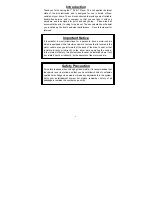
model no.
055-0361-0
| contact us: 1.866.523.5218
model no.
055-0361-0
| contact us: 1.866.523.5218
9
GENERATOR LOCATION
NEVER operate the generator inside any building including garages, basements,
crawlspaces, sheds, enclosure or compartment, including the generator compartment of a
recreational vehicle. Please consult your local authority. In some areas, generators must
be registered with the local utility. Generators used at construction sites may be subject to
additional rules and regulations. Generators should be on a flat, level surface at all times
(even while not in operation). Generators must have at least 5’ (1.5 m) of clearance from
all combustible material. In addition to clearance from all combustible material, generators
must also have at least 3’ (91.4 cm) of clearance on all sides to allow for adequate cooling,
maintenance and servicing. Generators should never be started or operated in the back of
a SUV, camper, trailer, in the bed of a truck (regular, flat or otherwise), under staircases/
stairwells, next to walls or buildings, or in any other location that will not allow for adequate
cooling of the generator and/or the muffler. DO NOT contain generators during operation.
Allow generators to properly cool before transport or storage.
∙ Place the generator in a well-ventilated area. DO NOT place the generator near vents
or intakes where exhaust fumes could be drawn into occupied or confined spaces.
Carefully consider wind and air currents when positioning generator.
∙ Do not operate or store the generator in rain, snow, or wet weather.
∙ Using a generator or electrical appliance in wet conditions, such as rain or snow, near a
pool or sprinkler system, or when your hands are wet, could result in electrocution.
∙ During operation the muffler and exhaust fumes produced will become hot. If adequate
cooling and breathing space are not supplied, or if the generator is blocked or contained,
temperatures can become extremely heated and may lead to fire.
SURGE PROTECTION
Electronic devices, including computers and many programmable appliances use
components that are designed to operate within a narrow voltage range and may be affected
by momentary voltage fluctuations. While there is no way to prevent voltage fluctuations, you
can take steps to protect sensitive electronic equipment.
∙ Install UL1449, CSA-listed, plug-in surge suppressors on the outlets feeding your
sensitive equipment.
∙ Surge suppressors come in single- or multi-outlet styles. They’re designed to protect
against virtually all short-duration voltage fluctuations.
∙ Voltage fluctuation may impair the proper functioning of sensitive electronic equipment.
!
WARNING: Failure to follow proper safety precautions may
void manufacturer’s warranty.
Oper
ation










































